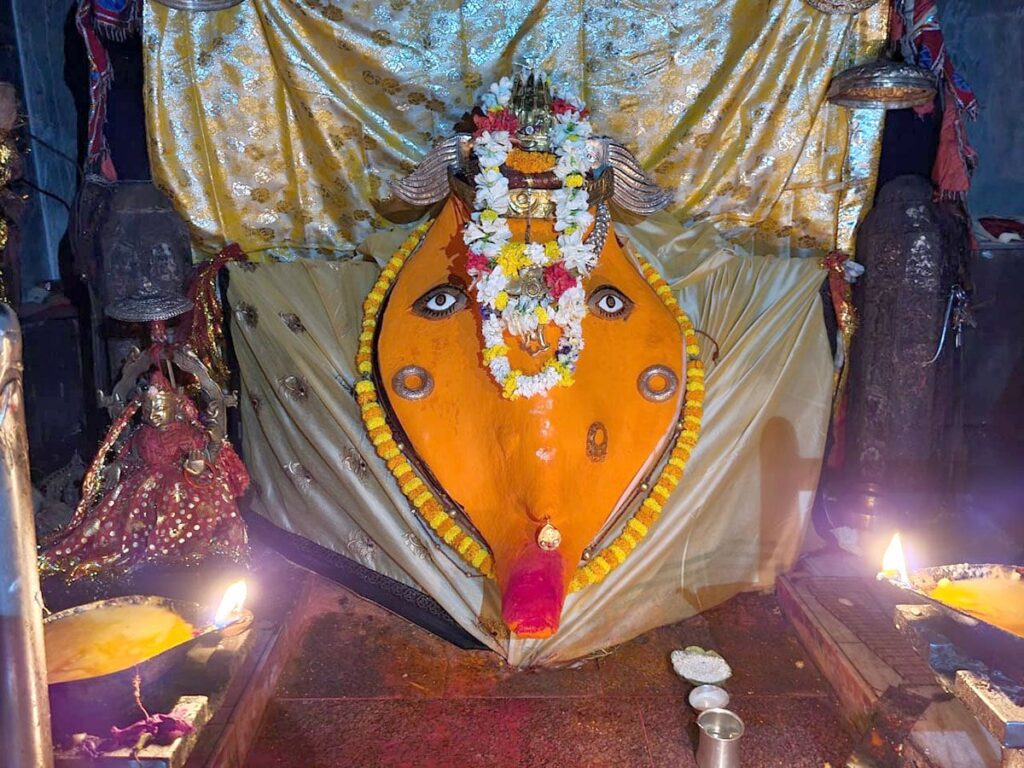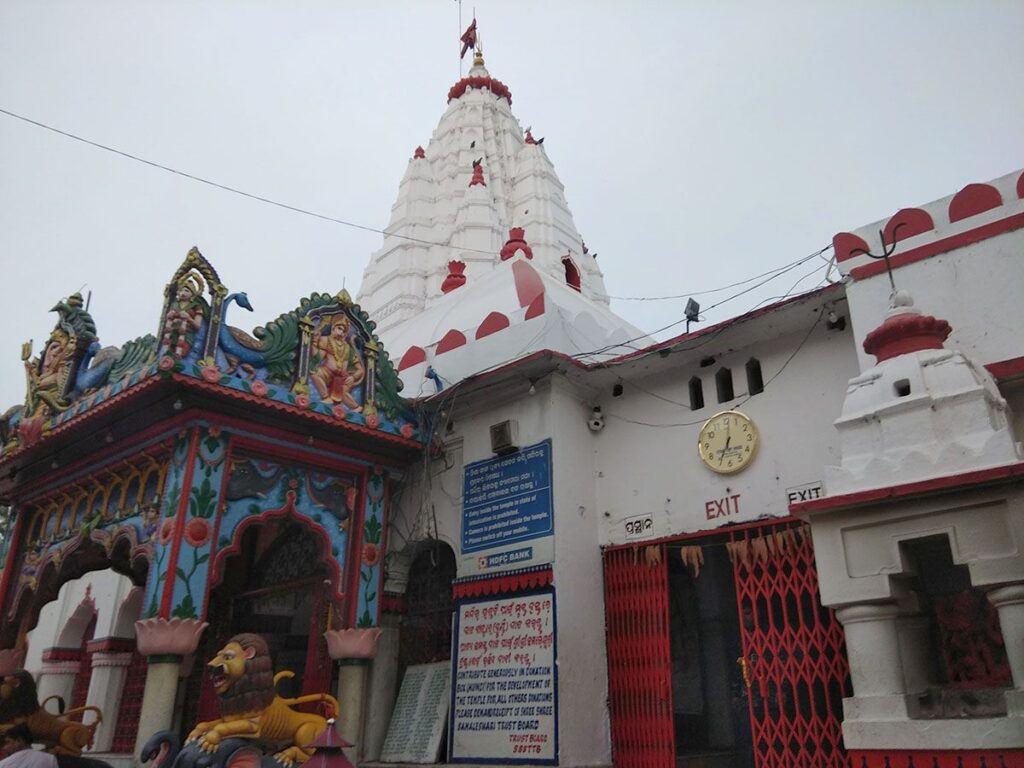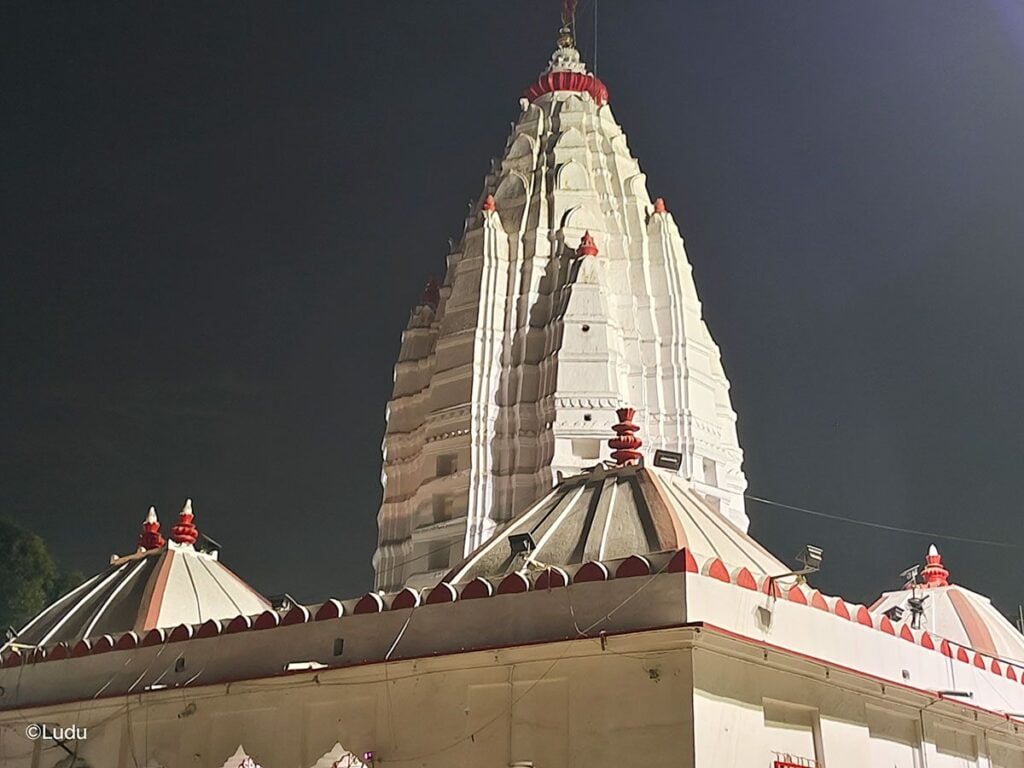Samaleswari Temple Sambalpur Odisha
Samaleswari Temple is a Hindu temple located in Sambalpur, Odisha, India. It is dedicated to the goddess Samaleswari, who is the presiding deity of Sambalpur. The temple is one of the oldest and most important temples in Odisha.

Contents
- 1 Samaleswari Temple History:
- 2 Legend of Samaleswari Temple:
- 3 Significance of Samaleswari Temple:
- 4 Myths of Samaleswari Temple:
- 5 Samaleswari Temple Architecture:
- 6 Samaleswari Temple Timing and Rituals:
- 7 Places to visit near Samaleswari Temple:
- 8 FAQ:
- 8.0.1 Q: What is Samaleswari Temple?
- 8.0.2 Q: Who is Goddess Samaleswari?
- 8.0.3 Q: What is the significance of Samaleswari Temple?
- 8.0.4 Q: When is the Sitalsasthi Carnival celebrated?
- 8.0.5 Q: What are the main rituals and festivals celebrated at Samaleswari Temple?
- 8.0.6 Q: Is there any historical significance associated with Samaleswari Temple?
- 8.0.7 Q: Is photography allowed inside the temple?
- 8.0.8 Q: What amenities are available at the temple?
- 9 How to reach Samaleswari Temple:
- 10 Google Maps:
Samaleswari Temple History:
Origins shrouded in mystery:
- Legends: Local lore suggests the temple site was originally a sacred grove where Goddess Samaleswari manifested under a Simili tree. Tribal communities are said to have worshipped her there as early as the 3rd century AD.
- Historical evidence: While the exact date is unknown, archaeological finds indicate the temple’s existence by the 8th century AD.
16th century construction:
- King Balaram Dev: The Chauhan dynasty ruler is credited with building the first temple structure in the mid-16th century. According to legend, he discovered the sacred grove and divine images, inspiring him to construct the temple.
17th century renovation:
- Chhatra Sai Dev: The 7th independent king of Sambalpur undertook a major renovation in 1657-1665. He used a unique, strong stone and endowed the temple with vast land holdings for its upkeep.
Unique practices and evolution:
- Ancient sacrifices: Historical accounts mention the practice of human sacrifice during construction, later transitioning to animal sacrifices. These practices were eventually discontinued altogether.
- Architectural style: The temple belongs to the Sandhara order, featuring a square sanctum sanctorum and a covered circumambulation path supported by pillars. Interestingly, eleven “parswa devis” (side goddesses) adorn the outer wall, allowing devotees to offer prayers during the “parikarma” ritual.
Read More>> Tara Tarini Temple Adi Shakti Odisha

Legend of Samaleswari Temple:
1. The Dream and the Simuli Tree:
- King Balaram Dev, camped along the Mahanadi, witnessed a strange sight: a white rabbit returning to a specific Simuli tree on the riverbank and disappearing.
- That night, he dreamt of Goddess Samaleswari, who revealed she resided beneath the tree and wished for a temple there.
- Heeding her divine call, Balaram Dev built the first temple at the designated spot, laying the foundation for the present structure.
2. The Sacrifice and the Foundation:
- A darker legend recounts the demand for human sacrifice during temple construction.
- Two individuals, Krupasindhu Panigrahi and his wife, volunteered, believing it would ensure the temple’s strength and stability.
- Their names are associated with the legend, though the practice, deemed barbaric, was thankfully discontinued long ago.
Additional Layers:
- Local tribes are said to have worshipped a mother goddess at the site centuries before any formal structure existed.
- The unique, natural rock formation resembling a face further fuels the belief in the ancient presence of the divine.
Read More>> 64 Chausath Yogini Temple Hirapur Odisha

Significance of Samaleswari Temple:
Religious Significance:
- Primary Deity: Goddess Samaleswari, embodying aspects of Adishakti, Mahalaxmi, Mahasaraswati, and Jagatjanani, is deeply revered by devotees seeking blessings for prosperity, knowledge, and well-being.
- Spiritual Center: The temple serves as a focal point for religious fervor, attracting devotees from Sambalpur, Odisha, and neighboring states like Chhattisgarh. Grand festivals like Nuakhai and Navratri draw thousands seeking spiritual fulfillment and community engagement.
- Ritualistic Practices: Unique rituals like “parikrama” (circumambulation) around the temple and offerings to the “parswa devis” continue to hold cultural significance and reinforce spiritual connection.
Cultural & Historical Importance:
- Ancient Roots: Legends link the temple site to early tribal worship, suggesting a link to the region’s rich cultural heritage.
- Architectural Heritage: The Sandhara architecture, dating back to the 16th and 17th centuries, reflects traditional building techniques and Odisha’s artistic legacy.
- Symbol of Sambalpur: The temple stands as a proud symbol of Sambalpur’s identity, reflecting its cultural and religious fabric.
Social & Socioeconomic Impact:
- Community Gathering: The temple acts as a social hub, fostering a sense of community and belonging among devotees.
- Economic Activity: Temple-related activities like tourism, trade, and local vendors generate economic opportunities for the surrounding community.
- Preservation of Traditions: The temple serves as a repository of oral history, traditional practices, and local legends, ensuring their transmission to future generations.
Read More>> Konark Sun Temple 13th Century Gem

Myths of Samaleswari Temple:
The Samaleswari Temple is steeped in rich folklore and mythical stories that add to its intrigue. Here are some of the most prominent ones:
1. Foundation Sacrifice:
One widely popular myth claims that during the temple’s construction, a king and his wife were buried alive as a human sacrifice to appease the Goddess. While historical records support some form of sacrifice being practiced in ancient times, human sacrifice specifically remains unverified and uncorroborated.
2. Self-Manifested Deity:
Another legend suggests that the Goddess Samaleswari initially manifested under a tree in the sacred grove where the temple now stands. Devotees, particularly from tribal communities, are said to have worshipped her at that site centuries before the temple’s construction.
3. Talking Idol:
Some myths claim that the Goddess spoke to King Balaram Dev, motivating him to build the temple. These myths often go hand-in-hand with the legend of the self-manifested deity, adding another layer of divinity to the story.
4. Granting Wishes:
Devotees believe that offering prayers and seeking blessings at the Samaleswari Temple can grant wishes and fulfill desires. Stories of individuals experiencing miracles and blessings after visiting the temple add to its mystical aura.
5. The Eye of the Goddess:
A popular myth suggests that the shallow cut on the rock formation, representing the Goddess’s mouth, will transform into an eye on a specific day and grant immense power to whomever witnesses it. However, the specific date and validity of this myth remain shrouded in mystery.
Read More>> Biraja Temple Shakti Peeth Jaipur
Samaleswari Temple Architecture:
The Two Structures:
The Samaleswari Temple is unique in its design, consisting of two separate structures:
- Badagudi: This larger section houses the main sanctum sanctorum where the idol of Goddess Samaleswari resides. It is a square-shaped structure built on a raised platform and features intricate carvings on its exterior walls.
- Sanagudi (Mandap): This smaller structure acts as a mandapa, housing idols of Lord Ganesha and other deities. It is also square-shaped and features pillars that support the roof.
Sandhara Order:
The temple belongs to the Sandhara order of Odisha temple architecture, characterized by:
- Square sanctum sanctorum: The innermost chamber where the main deity resides is always square-shaped.
- Covered circumambulation path: A walkway encircles the sanctum, allowing devotees to perform the “parikrama” ritual.
- Pillar support: The circumambulation path is supported by pillars, often intricately carved.
Key Architectural Features:
Here are some of the key architectural features of the Samaleswari Temple:
- Plinth: The temple stands on a high plinth, adding to its grandeur and visibility.
- Arched roof: The temple roof is arched, starting at a height of around 18 feet and tapering upwards.
- Carvings: The walls, pillars, and doorways are adorned with intricate carvings depicting deities, floral motifs, and geometric patterns.
- Parswa devis: Eleven “parswa devis” (side goddesses) are carved on the outer wall of the sanctum, allowing devotees to worship them during the “parikrama” ritual.
- Granite idol: The idol of Goddess Samaleswari is carved from a large block of granite and is a unique representation of the divine feminine.
Read More>> Sri Puri Jagannath Temple: The Lord of the Universe
Samaleswari Temple Timing and Rituals:
General Darshan Timings:
- Morning: 6:00 AM – 11:45 AM
- Afternoon: 3:00 PM – 5:00 PM
Closed Timings:
- 12:00 PM – 12:30 PM: Anna Lagi (Offering of food to the deity)
- 8:00 PM – 8:30 PM: Alati (Ritualistic waving of lamps)
Important Rituals:
- Puja Jiuntia Osha: Special ritual held throughout the year.
- Nuakhai: Celebrated on the occasion of offering the first harvest to the deity.
- Sohala Durga Puja: 16-day festival with specific rituals and decorations for the goddess.
- Navratri: Celebrated with great fervor, including lighting of Manasika Deepa (lamps for fulfilling wishes).
- Sandhi Puja and Mahastami Puja: Held on specific days during Navratri.
Read More>> Sacred Kashi Vishwanath Temple: 11th Jyotirling of Liberation
Places to visit near Samaleswari Temple:
- Hirakud Dam: One of the longest dams in the world, Hirakud Dam is situated on the Mahanadi River, approximately 15 kilometers from Sambalpur. The dam provides scenic views, and the nearby Gandhi Minar offers a panoramic perspective of the reservoir.
- Ushakothi Wildlife Sanctuary: Located about 43 kilometers from Sambalpur, this sanctuary is known for its diverse flora and fauna. It’s a great place for nature enthusiasts and wildlife photographers.
- Huma Temple: Situated about 32 kilometers from Sambalpur, Huma Temple is famous for its leaning tower, similar to the Tower of Pisa. The temple is dedicated to Lord Shiva and is located on the banks of the Mahanadi River.
- Debrigarh Wildlife Sanctuary: Around 40 kilometers from Sambalpur, this sanctuary is known for its scenic beauty and diverse wildlife. It offers opportunities for wildlife safaris and trekking.
- Sambalpur City: Explore the local markets, parks, and cultural attractions in Sambalpur. The city has a rich history and offers a glimpse into Odisha’s art and culture.
- Chiplima: Located around 37 kilometers from Sambalpur, Chiplima is known for its hydroelectric project and a picturesque waterfall. The area is ideal for a day trip and picnics.
- Ghanteswari Temple: Situated about 33 kilometers from Sambalpur, this temple is known for its bells. Devotees tie bells in the temple premises, and the ringing sound creates a serene atmosphere.
- Pradhanpat Waterfall: Approximately 95 kilometers from Sambalpur, Pradhanpat Waterfall is surrounded by lush greenery and offers a peaceful environment. It’s a great place for nature lovers.
FAQ:
Q: What is Samaleswari Temple?
A: Samaleswari Temple is a Hindu temple dedicated to Goddess Samaleswari, a form of the goddess Mahakali, situated in the town of Sambalpur in the state of Odisha, India. The temple is a significant pilgrimage site and holds cultural and religious importance in the region.
Q: Who is Goddess Samaleswari?
A: Goddess Samaleswari is considered a form of Mahakali, the fierce and powerful aspect of the goddess Devi in Hinduism. Samaleswari is revered as the guardian deity of Sambalpur and is believed to protect the town and its inhabitants.
Q: What is the significance of Samaleswari Temple?
A: Samaleswari Temple is a revered pilgrimage destination for devotees seeking the blessings and protection of Goddess Samaleswari. The temple holds cultural and historical significance in the region, and the deity is worshipped with great devotion. The annual Sitalsasthi Carnival, a major festival in Sambalpur, is associated with the marriage ceremony of Lord Shiva and Goddess Samaleswari and attracts a large number of devotees and tourists.
Q: When is the Sitalsasthi Carnival celebrated?
A: The Sitalsasthi Carnival is an annual festival celebrated in Sambalpur, usually in the month of June. The festival marks the symbolic marriage ceremony of Lord Shiva and Goddess Samaleswari, and it includes various processions, cultural events, and religious rituals.
Q: What are the main rituals and festivals celebrated at Samaleswari Temple?
A: Besides the Sitalsasthi Carnival, the Samaleswari Temple observes various other festivals and rituals. Some of the significant ones include Navaratri, Durga Puja, and the annual Rath Yatra (chariot procession). These events attract a large number of devotees who come to participate in the religious activities and seek the blessings of Goddess Samaleswari.
Q: Is there any historical significance associated with Samaleswari Temple?
A: The Samaleswari Temple has historical roots, and its establishment is attributed to the Chauhan dynasty rulers. Over the centuries, the temple has undergone renovations and modifications. It stands as a symbol of the rich cultural and religious heritage of the region.
Q: Is photography allowed inside the temple?
A: Photography is generally not permitted within the sanctum sanctorum. Respect the temple’s rules and avoid taking pictures where prohibited.
Q: What amenities are available at the temple?
A: There are cloakrooms, shoe stands, and prasadam stalls within the temple complex. However, it’s best not to bring valuables as safekeeping facilities might be limited.
How to reach Samaleswari Temple:
By Air: The nearest airport to Sambalpur is the Veer Surendra Sai Airport (formerly known as Jharsuguda Airport), which is approximately 55 kilometers away. From the airport, you can hire a taxi or use other local transportation options to reach Sambalpur.
By Train: Sambalpur Junction is a major railway station in the region and is well-connected to various cities across India. You can check for trains that connect to Sambalpur and plan your journey accordingly. From the Sambalpur Junction, you can take a taxi, auto-rickshaw, or other local transportation to reach the Samaleswari Temple.
By Road: Sambalpur is well-connected by road, and there are regular bus services from nearby cities and towns. You can also hire a taxi or drive to Sambalpur if you prefer traveling by car. The road network in the region is generally good, making it a convenient option for travelers.
